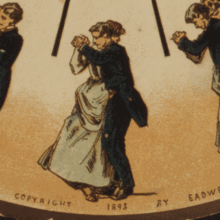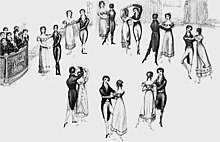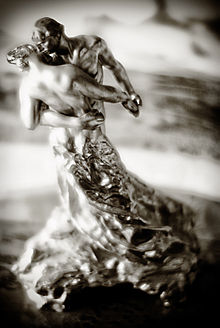Waltz
 Aphenakistoscopeanimation byEadweard Muybridgedemonstrating the waltz | |
| Genre | Ballroom dance |
|---|---|
| Time signature | 3 4 |

Thewaltz(fromGermanWalzer[ˈvalt͡sɐ̯]), meaning "to roll or revolve" )[1]is aballroomandfolk dance,normally in triple (3
4time), performed primarily inclosed position.
History
[edit]There are many references to a sliding or gliding dance, includingvolte,that would evolve into the waltz that date from 16th-century Europe, including the representations of theprintmakerHans Sebald Beham.The French philosopherMichel de Montaignewrote of a dance he saw in 1580 inAugsburg,where the dancers held each other so closely that their faces touched. Kunz Haas (of approximately the same period) wrote, "Now they are dancing the godlessWellerorSpinner."[2]"The vigorous peasant dancer, following an instinctive knowledge of the weight of fall, uses his surplus energy to press all his strength into the proper beat of the bar, thus intensifying his personal enjoyment in dancing."[2]Around 1750, the lower classes in the regions ofBavaria,Tyrol,andStyriabegan dancing a couples dance calledWalzer.[3]TheLändler,also known as theSchleifer,a country dance in3
4time, was popular inBohemia,Austria,and Bavaria, and spread from the countryside to the suburbs of the city. While the eighteenth-century upper classes continued to dance theminuets(such as those byMozart,HaydnandHandel), bored noblemen slipped away to the balls of their servants.[4]
In the 1771 German novelGeschichte des Fräuleins von SternheimbySophie von La Roche,a high-minded character complains about the newly introduced waltz among aristocrats thus: "But when he put his arm around her, pressed her to his breast, cavorted with her in the shameless, indecent whirling-dance of the Germans and engaged in a familiarity that broke all the bounds of good breeding—then my silent misery turned into burning rage."[5]
Describing life inVienna(dated at either 1776 or 1786[6]), Don Curzio wrote, "The people were dancing mad... The ladies of Vienna are particularly celebrated for their grace and movements of waltzing of which they never tire." There is a waltz in the second act finale of the 1786 operaUna Cosa RarabyMartin y Soler.Soler's waltz was markedandante con moto,or "at a walking pace with motion", but the flow of the dance was sped-up in Vienna leading to theGeschwindwalzer,and theGalloppwalzer.[7][8]
In the 19th century, the word primarily indicated that the dance was a turning one; one would "waltz" in thepolkato indicate rotating rather than going straight forward without turning.
Shocking many when it was first introduced,[9]the waltz became fashionable inViennaaround the 1780s, spreading to many other countries in the years to follow. According to contemporary singer Michael Kelly, it reached England in 1791.[10]During theNapoleonic Wars,infantry soldiers of theKing's German Legionintroduced the dance to the people of Bexhill, Sussex, from 1804.[11]
It became fashionable inBritainduring theRegency period,having been made respectable by the endorsement ofDorothea Lieven,wife of the Russian ambassador.[12]DiaristThomas Raikeslater recounted that "No event ever produced so great a sensation in English society as the introduction of the waltz in 1813."[13]In the same year, a sardonic tribute to the dance by Lord Byron was anonymously published (written the previous autumn).[14][15]Influential dance master and author of instruction manuals, Thomas Wilson publishedA Description of the Correct Method of Waltzingin 1816.[16]Almack's,the most exclusive club in London, permitted the waltz, though the entry in theOxford English Dictionaryshows that it was considered "riotous and indecent" as late as 1825. InThe Tenant of Wildfell Hall,byAnne Brontë,in a scene set in 1827, the local vicar Reverend Milward tolerates quadrilles and country dances but intervenes decisively when a waltz is called for, declaring "No, no, I don't allow that! Come, it's time to be going home."[17]
The waltz, especially its closed position, became the example for the creation of many other ballroom dances. Subsequently, new types of waltz have developed, including many folk and several ballroom dances.
Variants
[edit]This sectionneeds additional citations forverification.(May 2019) |



In the 19th and early 20th century, numerous different waltz forms existed, including versions performed in3
4,3
8or6
8(sauteuse), and5
4time (5
4waltz, half and half).
In the 1910s, a form called the Hesitation Waltz was introduced byVernon and Irene Castle.[19]It incorporated "hesitations" and was danced to fast music. A hesitation is basically a halt on the standing foot during the full waltz bar, with the moving foot suspended in the air or slowly dragged. Similar figures (Hesitation Change,Drag Hesitation,andCross Hesitation) are incorporated in theInternational StandardWaltz Syllabus.
The Country Western Waltz is mostly progressive, moving counter clock wise around the dance floor. Both the posture and frame are relaxed, with posture bordering on a slouch. The exaggerated hand and arm gestures of some ballroom styles are not part of this style. Couples may frequently dance in thepromenade position,depending on local preferences. Within Country Western waltz, there is the Spanish Waltz and the more modern (for the late 1930s- early 1950s) Pursuit Waltz. At one time it was considered ill treatment for a man to make the woman walk backwards in some locations.[20]
In California, the waltz was banned by Mission priests until 1834 because of the "closed" dance position.[21]Thereafter a Spanish Waltz was danced. This Spanish Waltz was a combination of dancing around the room in closed position, and a "formation" dance of two couples facing each other and performing a sequence of steps.[21]"Valse a Trois Temps" was the "earliest" waltz step, and the Rye Waltz was preferred as a couple dance.[22]
- In contemporaryballroom dance,the fast versions of the waltz are calledViennese waltzas opposed to theSlow waltz.[23]
- Intraditional Irish music,the waltz was taught by travelling dancing masters to those who could afford their lessons during the 19th century. By the end of that century, the dance spread to the middle and lower classes of Irish society and traditional triple-tune tunes and songs were altered to fit the waltz rhythm. During the 20th century, the waltz found a distinctively Irish playing style in the hands ofCéilidhmusicians atdances.[24][25]
- International Standard Waltzhas only closed figures; that is, the couple never breaks the embrace.
- TheAmerican Style Waltz,part of theAmerican Smoothballroom dance syllabus, in contrast to theInternational StandardWaltz, involves breaking contact almost entirely in some figures. For example, the Syncopated Side-by-Side with Spin includes a free spin for both partners. Open rolls are another good example of anopen dance figure,in which the follower alternates between the lead's left and right sides, with the lead's left or right arm (alone) providing the lead. Waltzes were the staple of many American musicals and films, including "Waltz in Swing Time" sung byFred Astaire.[citation needed]
- The Scandinavian Waltz, performed as a part ofScandinavian folk dance,can be fast or slow, but the dancers are always rotating.[citation needed]
- ThePeruvian Waltzis called and recognised in Peru asvals criollo.[citation needed]
- TheMexican Waltz(vals mexicano) follows the same basic rhythmic pattern as the standard waltz, but the melodies reflect a strong Spanish influence. Mexico'sJuventino Rosaswrote "Sobre las Olas"or" Over the Waves ".
- TheCajun Waltzis danced progressively around the floor, and is characterised by the subtle swaying of the hips and step very close to ordinary walking. It is danced entirely in the closed position.[citation needed]
- The Cuban (or Tropical) Waltz follows the pattern of the standard waltz throughout the song.[citation needed]
- TheVenezuelan waltzprovided a basis for distinctive regional musical composition.[citation needed]
- The Contra Waltz (Freeform Waltz), included in mostcontra danceevenings, uses both open and closed positions, and incorporates moves from other dances such asswing,modern jiveandsalsa.Basically the dancers progress around the dance floor with a waltz step, but with no constraints on what moves they can use.[citation needed]
- TheValse Musette,a form of waltz popular in France, started in the late 19th century.[citation needed]
- Thecross-step waltz(French Valse Boston) developed in France in the early 20th century and is popular in social waltz groups today.[citation needed]
- In folk dance from theAlsaceregion, waltzes in odd metres such as5
4,8
4and11
4are found. In modernbal folk,waltzes in even higher metres are played and danced. - Estonianfolk danceLabajalavalss(flat of the foot waltz) performed in3
4time.[26] - Sama'i(also known as usul semai) is a vocal piece of Ottoman Turkish music composed in 6/8 metres. This form and metre (usul in Turkish) is often confused with the completely different Saz Semaisi, an instrumental form consisting of three to four sections, in 10/8 metre, or usul aksak semai (broken semai in Turkish). Semai is one of the most important forms in Ottoman Turkish Sufi music.[27][28]
- TheTsamikos(Greek:Τσάμικος,Tsamikos) orKleftikos(Greek:Κλέφτικος) is a popular traditionalfolk danceofGreece,done to music of3
4metre.[29]
References
[edit]
- ^Etymology Online
- ^abNettl, Paul. "Birth of the Waltz." InDance Indexvol 5, no. 9. 1946 New York: Dance Index-Ballet Caravan, Inc. pages 208, 211
- ^Wechsberg, Joseph (1973).The Waltz Emperors: The Life and Times and Music of the Strauss Family.Putnam. p. 49.ISBN978-0-399-11167-9.
- ^Sir George Grove, John Alexander Fuller-Maitland, Adela Harriet Sophia (Bagot) Wodehouse.A Dictionary of Music and Musicians (A.D. 1450–1880)Published 1889. Macmillan
- ^The History of Lady Sophia Sternheim,trans. Christa Baguss Britt (State University of New York Press, 1991), p. 160.
- ^Jacob, H.E. (2005).Johann Strauss: Father and Son a Century of Light Music.pp. 24–25.ISBN1-4179-9311-1.
- ^Wechsberg.The Waltz Emperors.1973. C. Tinling & Company. page 49, 50)
- ^Grove's Dictionary,page 385
- ^Gutman, Robert W. (1999).Mozart: A Cultural Biography.Harcourt. pp. 44–45.
- ^Scholes, Percy.The Oxford Companion to Music.10th edition, 1991. page 1110
- ^SussexWeekly Advertiser,21 January 1805
- ^Hilton, Boyd (2006).A Mad, Bad, and Dangerous People? England 1783–1846.Oxford University Press.
- ^Raikes, Thomas(1856).A Portion of the Journal Kept by Thomas Raikes from 1831 to 1847: Comprising Reminiscences of Social and Political Life in London and Paris During that Period.pp. 240–243.Retrieved20 September2015.
- ^"Introduction to 'The Waltz'".Readbookonline.org.
- ^Childers, William (1969). "Byron's" Waltz ": The Germans and Their Georges".Keats-Shelley Journal.18.Keats-Shelley Association of America, Inc.: 81–95.JSTOR30212687.
- ^Fullerton, Susannah (2012).A dance with Jane Austen: how a novelist and her characters went to the ball(1st Frances Lincoln ed.). London, England: Frances Lincoln Ltd. pp. 110–111.ISBN978-0-7112-3245-7.
- ^Penguin edition 1964, page 42
- ^abBlatter, Alfred (2007).Revisiting music theory: a guide to the practice.Taylor & Francis. p.28.ISBN978-0-415-97440-0.
- ^"The History of Ballroom Dance in America".Archived fromthe originalon 2011-03-06.Retrieved2010-12-13.
- ^Shaw, Lloyd (1939).Cowboy Dances.The Caxton Printers. pp. 101–103.
- ^abCzarnoski, Lucile K (1950).Dances of Early California Days.Pacific Books. p. 44.
- ^Czarnoski, Lucile K (1950).Dances of Early California Days.Pacific Books. p. 121.
- ^"Information on Styles of Waltz include American, International, C&W, Viennese Waltz and others!".Dancetime.2012-09-09.Retrieved2017-10-02.
- ^Vallely, F. (1999).The Companion to Traditional Irish Music.New York: New York University Press. pp. 431–433.
- ^"Rhythm Definitions - Irish Traditional Music Tune Index".Irishtune.info. 2012-07-11.Retrieved2012-11-07.
- ^"Estonian".Common Ground on the Hill.Retrieved2020-05-17.
- ^Friedlander, Shems; Uzel, Nezih (January 1992).The Whirling Dervishes.SUNY Press.ISBN9780791411551.Retrieved30 December2016.
- ^"AllMusic Review by James Manheim".AllMusic.Retrieved30 December2016.
- ^"yamahamusicsoft".Archived fromthe originalon 1 January 2017.Retrieved1 January2017.
External links
[edit]- Waltz basic steps
- Music regarding: Waltz within traditional dances of the County of Nice (France)
- Scroll to "Five Step Waltz" for notes about probable 1847 origin and associated music published the same year.
- Thomas Wilson's 1816 Waltz Manual
- The Dance of DeathatProject Gutenberg(1877 Book critical of the Waltz)
- The Regency Waltz
- Waltzes under CreativeCommons licence on BalLibre.org
- Wedding Waltz
